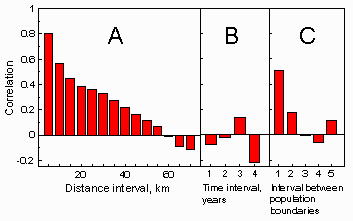Spread Rate Autocorrelations

Fig. 1. Autocorrelation of gypsy moth spread rate in space (along the boundary) (A), in time (over the years) (B), and over population thresholds of 1, 3, 10, 30, 100 and 300 moths/trap (C).
Correlation range in space was ca. 60 km. In order to get some level of independent replication in samples, a boundary length of 100 km is sufficient to obtain a useful level of precision in its average position.
No autocorrelation in spread rate over time was detected. This indicates that data from different years are true replications which can increase precision for comparison of boundary changes.
Moderate autocorrelation was detected among adjacent population boundaries. Population spread rates estimated using more distant population thresholds were not correlated, and thus, they can be used as true replications to increase the precision. We suggest that comparisons be made using the entire scope of male catch thresholds from 1 to 300 moths/trap. The width of the evaluation zone (measured perpendicular to the population boundary) should be ca. 100 km to cover all male catch thresholds from 1 to over 300 males/trap.
 Back to STS Evaluation
Back to STS Evaluation
 Back to Analysis
of Population Spread
Back to Analysis
of Population Spread
For more information, please contact Patrick Tobin or Andy Roberts
Maintained By Jiang Wu